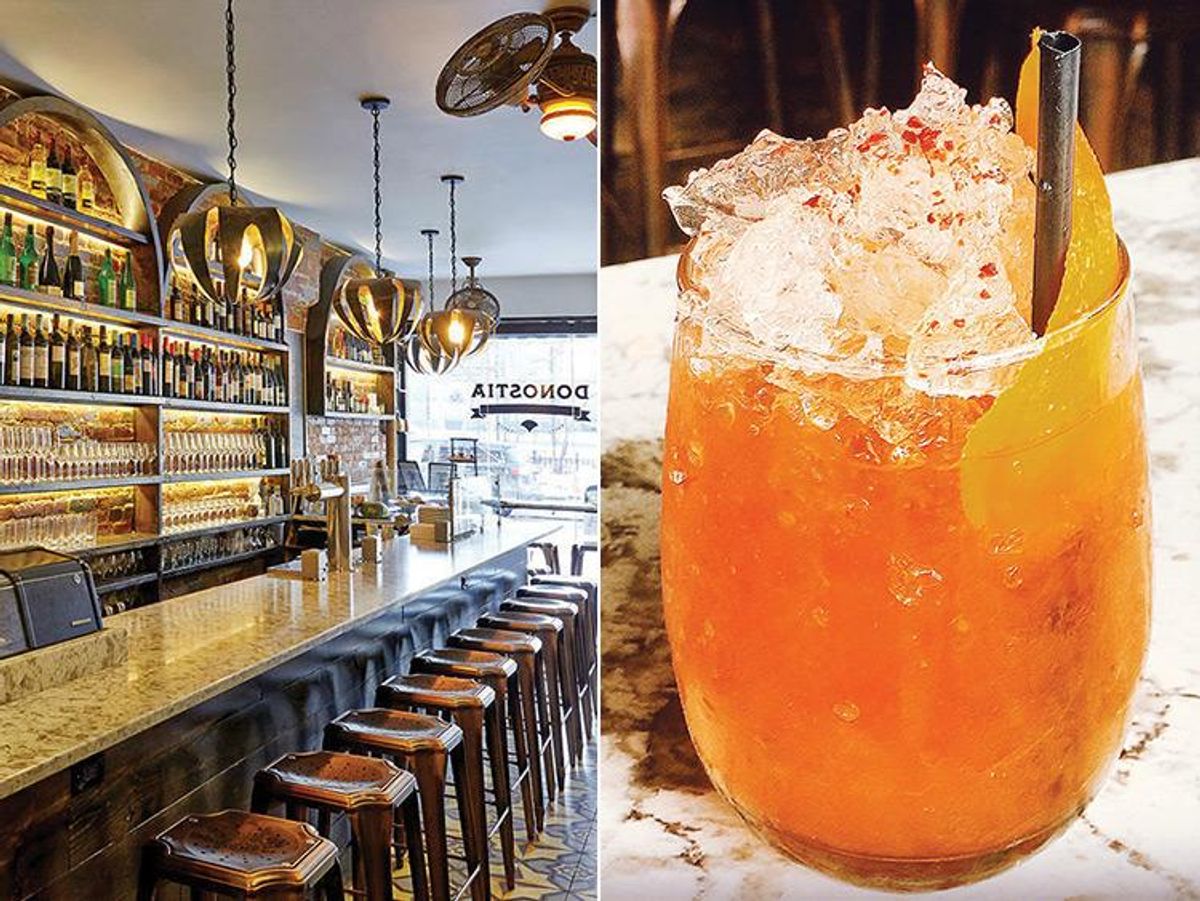Liquidity
Everything You Didn't Know About Sherry

Sherry is playing the field, from sommelier's lists to tapas bars.
August 12 2016 11:00 AM EST
September 13 2018 5:52 AM EST
By continuing to use our site, you agree to our Private Policy and Terms of Use.

Sherry is playing the field, from sommelier's lists to tapas bars.
Courtesy of Donostia (The Chingon Cobbler). Courtesy of Brian Tizia (Donostia interior).
A little knowledge can be a dangerous thing. Take sherry, for example. Its recent revival on bar menus and sommeliers' lists is proof that it's more than just the sickly-sweet stuff British grandmas sip at Christmas. But just hearing about the many complex-sounding varieties of this Spanish wine -- oloroso, amontillado, fino, palo cortado -- is enough to make most drinkers swear off the stuff completely. Don't give up. Sherry mastery can be yours, and it'll be worth it.
One of the reasons sherry has become a bartender's darling is its extreme versatility. Its five main varieties -- the light, saline fino; amontillado; palo cortado; oloroso; and the syrupy, dark Pedro Ximenez -- cover a wide range of flavor profiles that can enhance pretty much any cocktail. As Derek Brown, owner of Washington, D.C.'s sherry-centric Mockingbird Hill (DrinkMoreSherry.com) and cocktail-focused Columbia Room (ColumbiaRoomDC.com), says: "It's such an incredible beverage because of how it both mixes in cocktails and resonates with food."
That versatility is put to good use in Columbia Room's old-fashioned variation, the Right Side Up. The nutty, spicy characteristics of oloroso sherry play up the rye whiskey, while the addition of pineapple provides a floral, fragrant sweetness. Meanwhile, patrons at New York's Donostia (DonostiaNYC.com), a Basque-style tapas bar, don't even notice its lack of hard liquor thanks to a broad sherry list and its ingenious house-made syrups. The cocktail list there includes the Chingon Cobbler, which boosts the classic sherry cobbler equation with amontillado and manzanilla sherries.
But as Brown attests, sherry really shines when paired with food. It can do everything wine does and more. The protective yeast covering (or flor) that keeps fino and amontillado light also adds a saline edge unlike any other; it primes the palate and plays well with fried foods and oysters. Amontillados and olorosos are darker and go well with red meat. And all sherries are great for sipping pre-dinner with a handful of olives or bar nuts, as the Spanish do.
No matter how you try it, sherry offers something new, to both casual and experienced drinkers. Don't worry about the details -- Brown says, "If we were talking about chardonnay, I wouldn't feel the need to explain how it's made." Start your discovery on your own terms.
Drink These Now
The best way to get acquainted with sherry? Try more sherry. Here, three of our favorites to sip au naturel.
Tio Pepe (Gonzalez Byass)
The best-known fino is also one of the best, full stop, and a perfect introduction to the style. It's light, slightly saline, and incredibly refreshing -- just the thing on a sultry, early-fall afternoon.
Vina AB Amontillado (Gonzalez Byass)
Take Tio Pepe, age it an additional 12 years, and what do you get? A well-rounded, hazelnutty amontillado that doesn't weigh down the palate. Its bright acidity makes it a brilliant match for a number of dishes, from tomato salads to steak.
La Bota 46 de Oloroso (Equipo Navazos)
Aged for about 25 years without flor, this oloroso is deep, dark, and built for sipping. With a hint of apricot and lots of nutty almond on the nose, it's an excellent sidekick for an after-dinner cheese course.
Like what you see here? Subscribe and be the first to receive the latest issue of OUT. Subscribe to print here and receive a complimentary digital subscription.
Sexy MAGA: Viral post saying Republicans 'have two daddies now' gets a rise from the right